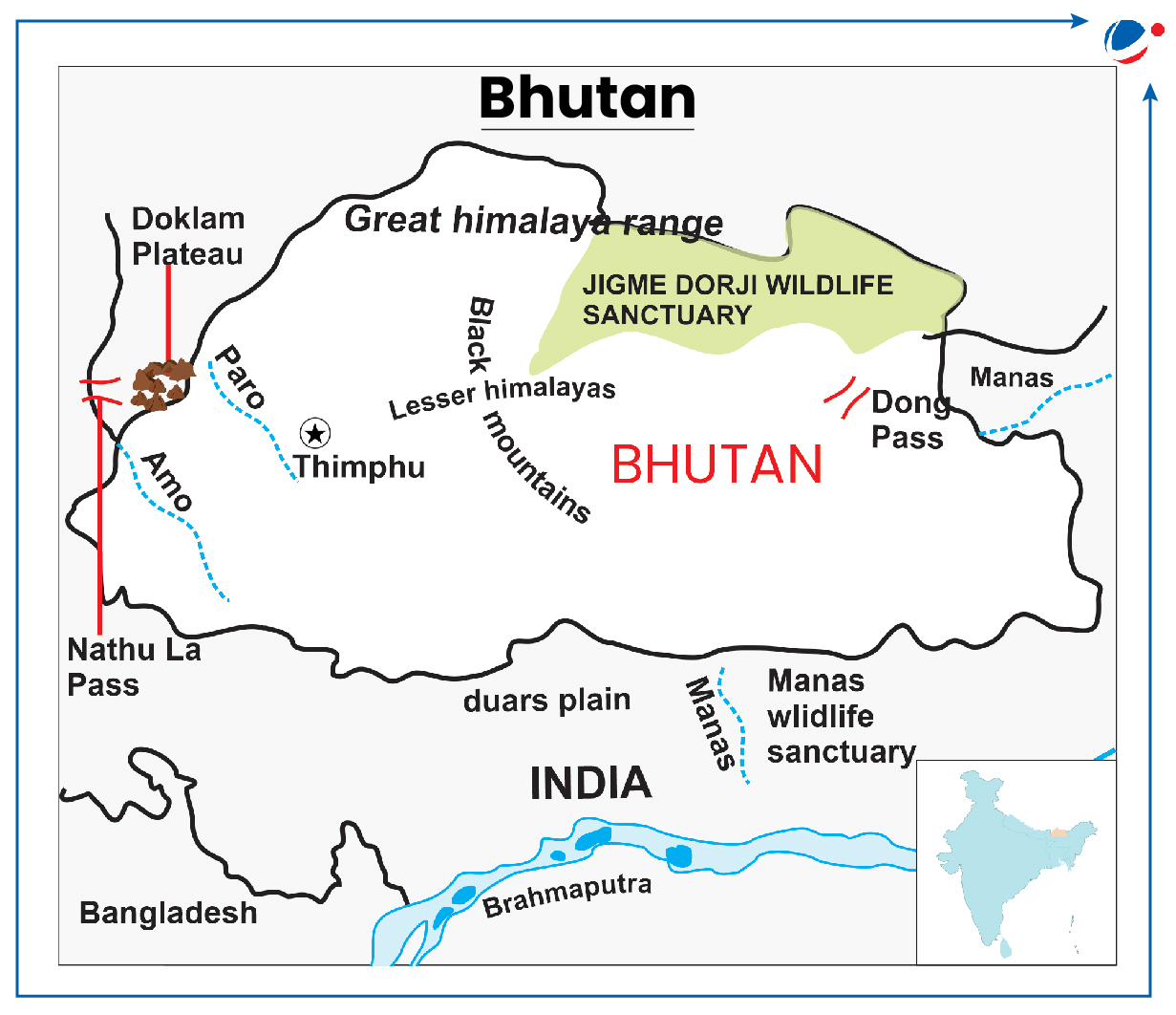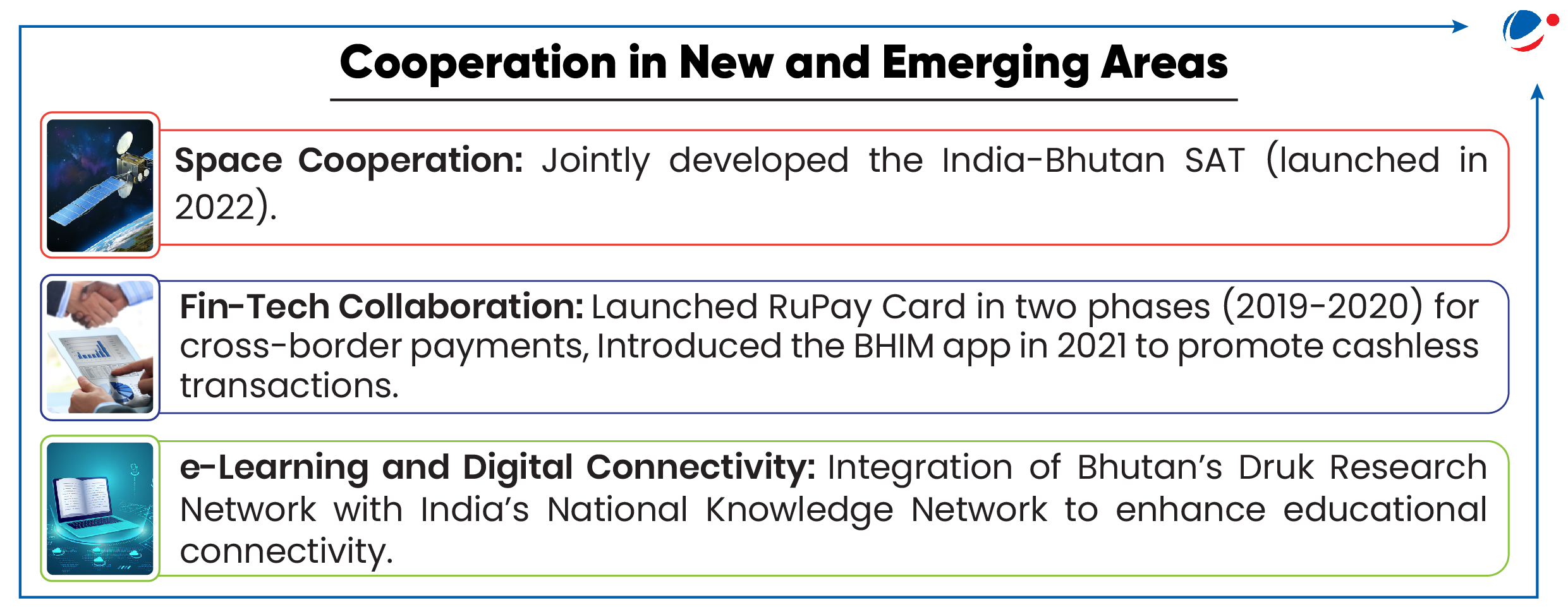Why in the News?
The King and the Queen of Bhutan were on an official visit to India.

Key Highlights of the Visit
- India's Prime Minister reassured Bhutan's King of India's continued support for the Gelephu Mindfulness City project, enhancing prosperity.
- The city is a 2500 Km zero-carbon, co-operative project that will offer space to businesses in finance, tourism, green energy, technology, healthcare, agriculture, aviation, logistics, education and spirituality.
- Expressed satisfaction over-
- Inauguration of first Integrated Check Post (ICP) along the India-Bhutan border at Darranga in Assam.
- 1020 MW Punatshangchhu-II hydro power project was nearing completion.
Significance of India- Bhutan Bilateral Relations
For Both countries
- Robust political relationship: Highlighted by Treaty of Friendship, which was first signed in 1949 and renegotiated in 2007.
- Formal diplomatic relations were established in 1968.

- Mutually beneficial hydro-power cooperation: The 2006 bilateral agreement and its 2009 Protocol govern hydropower cooperation with benefits for both countries.
- For Bhutan: India provides Bhutan access to Indian financing and energy markets to support hydro-power development, which is a vital catalyst for the country's socio-economic development.
- E.g., India facilitated the access of Basochhu hydropower and Nikachhu hydropower plants for trading on Day Ahead and Real Time Markets in the Indian Power Exchanges.
- For India: Clean energy imported from Bhutan alleviates power deficiency sustainably.
- For Bhutan: India provides Bhutan access to Indian financing and energy markets to support hydro-power development, which is a vital catalyst for the country's socio-economic development.
- India-Bhutan Buddhist Connect: Both countries promote pilgrimage at important Buddhist sites.
- Kolkata's Asiatic Society also loaned statue of 16th-century monk Zhabdrung Ngawang Namgyal, regarded as the founder of the modern nation state of Bhutan, to Bhutan.
- Transboundary wildlife conservation: E.g., Both countries collaborate through Transboundary Manas Conservation Area (TraMCA) to protect the wildlife in Manas National Park in India and Royal Manas National Park in Bhutan.
For Bhutan
- Free trade regime: India-Bhutan Agreement on Trade, Commerce and Transit, first signed in 1972 (revised in 2016), establishes a Free Trade Regime between the two countries.
- It allows duty-free transit of Bhutanese exports to third countries.
- Developmental assistance: India has stepped up the development support for Bhutan under their 13th Five Year Plan (2024-29) and also supports Bhutan's Economic Stimulus Programme.
- India as a net security provider:
- Doklam Standoff: India invoked the India-Bhutan Treaty of Perpetual Friendship 2007 to intervene on Bhutanese territory (which China claims) to prevent the China from constructing a road to Gipmochi In 2017.
- IMTRAT: The Indian Military Training Team (IMTRAT), established in 1961-62, provides training to Bhutanese forces.
- Infrastructure Development: India's Border Road Organisation (BRO) has constructed the majority of roads in Bhutan under Project 'DANTAK'.
- Other Areas of support from India:
- Scholarships for Bhutanese students to study in India;
- India contributes to 50% of the Bhutan's total foreign direct investment (FDI);
- India provides financial support for 'Digital Drukyul' for establishing optical fibre in Bhutan etc.
For India
- Trade: India is Bhutan's largest trade partner with balance of trade favouring India.
- Strategic location: Bhutan is a strategic partner of India as it acts as a buffer between China and India, especially along the sensitive Chumbi Valley.

Growing Concerns in India-Bhutan Relations
- Increasing Proximity between China and Bhutan:
- While Bhutan does not have a diplomatic presence in China, 2023 marked first-ever visit by a Bhutanese Foreign Minister to China.
- China significantly influences Bhutan's economy, accounting for over 25% of its trade.
- Bhutanese are inclined towards establishing diplomatic relations with China and resolving the border issue.
- Chinese Territorial Assertiveness: China considers Bhutan as part of its "five-finger policy," which views Tibet as the palm and Ladakh, Nepal, Sikkim, Bhutan, and Arunachal Pradesh as the fingers.
- Bhutan-China border disputes: Bhutan and China signed a "three-step roadmap" in October 2021 to expedite boundary dispute resolution.
- India fears China may pressure Bhutan to cede access or control over the Doklam plateau, threatening India's strategic Siliguri Corridor.
- Other challenges:
- Militant groups: India's North-East militant groups, such as United Liberation Front of Assam (ULFA) & National Democratic Front of Bodos (NDFB), use Bhutan as a hideout.
- Stalled projects: Bhutan has stalled the BBIN Motor Vehicle Agreement (Bangladesh, Bhutan, India, Nepal) over environmental concerns.
Conclusion
As Bhutan navigates its relations with China, India's engagement remains crucial to Bhutan's regional security and autonomy, ensuring both nations continue to prosper together while addressing emerging challenges. India should focus on enhancing economic cooperation through continued development assistance and strengthening mutual security commitments. Moreover, Bilateral relations can be further strengthened in areas like educational collaborations that strengthens human connections and exploring deep-rooted cultural ties.






